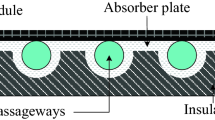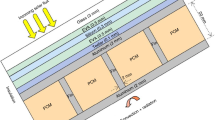Abstract
A novel building integrated photovoltaic thermal (BIPVT) roofing panel has been designed considering both solar energy harvesting efficiency and thermal performance. The thermal system reduces the operating temperature of the cells by means of a hydronic loop integrated into the backside of the panel, thus resulting in maintaining the efficiency of the solar panels at their feasible peak while also harvesting the generated heat for use in the building. The performance of the proposed system has been evaluated using physical experiments by conducting case studies to investigate the energy harvesting efficiency, thermal performance of the panel, and temperature differences of inlet/outlet working liquid with various liquid flow rates. The physical experiments have been simulated by coupling the finite element method (FEM) and finite volume method (FVM) for heat and mass transfer in the operation. Results show that the thermal system successfully reduced the surface temperature of the solar module from 88 °C to as low as 55 °C. Accordingly, the output power that has been decreased from 14.89 W to 10.69 W can be restored by 30.2% to achieve 13.92 W. On the other hand, the outlet water from this hydronic system reaches 45.4 °C which can be used to partially heat domestic water use. Overall, this system provides a versatile framework for the design and optimization of the BIPVT systems.
Similar content being viewed by others
Abbreviations
- D :
-
diameter of the tube
- L :
-
characteristic length of the tube
- Q :
-
quantum of the flow meter
- Re :
-
Reynolds number
- t :
-
time (min)
- u :
-
flow speed
- V :
-
kinematic viscosity
References
Ananthachar V (2008). Current and next generation solar cell market outlook. In: Proceedings of ISES World Congress.
Bejan A (2013). Convection Heat Transfer, 4th edn. Hoboken, NJ, USA: John Wiley & Sons.
Chen F, Yin H (2016). Fabrication and laboratory-based performance testing of a building-integrated photovoltaic-thermal roofing panel. Applied Energy, 177: 271–284.
Chen F, Pao F, Yin H (2018). Advanced building integrated photovoltaic/thermal technologies. In: Letcher TM, Fthenakis VM (eds), A Comprehensive Guide to Solar Energy Systems. Amsterdam: Elsevier.
De la Torre J, Bremond G, Lemiti M, et al. (2006). Silicon nanostructured layers for improvement of silicon solar cells’ efficiency: A promising perspective. Materials Science and Engineering: C, 26: 427–430.
Dyga R, Witczak S (2012). Investigation of effective thermal conductivity aluminum foams. Procedia Engineering, 42: 1088–1099.
Fraas LM (2014). History of solar cell development. In: Low-Cost Solar Electric Power. Cham, Switzerland: Springer.
Fthenakis VM, Lynn PA (2018). Electricity from Sunlight: Photovoltaic-Systems Integration and Sustainability. Hoboken, NJ, USA: John Wiley & Sons.
Ghani F, Duke M, Carson JK (2012). Estimation of photovoltaic conversion efficiency of a building integrated photovoltaic/thermal (BIPV/T) collector array using an artificial neural network. Solar Energy, 86: 3378–3387.
Ghosh K (2017). Status and Technology of Present Day Solar Cells. In: Proceedings of the 3rd International Conference, OPTRONIX 2016.
Lamnatou C, Mondol JD, Chemisana D, et al. (2015). Modelling and simulation of Building-Integrated solar thermal systems: behaviour of the coupled building/system configuration. Renewable and Sustainable Energy Reviews, 48: 178–191.
LeVeque RJ (2002). Finite Volume Methods for Hyperbolic Problems. Cambridge, UK: Cambridge University Press.
Lin Q, Zhang Y, Van Mieghem A, et al. (2020). Design and experiment of a sun-powered smart building envelope with automatic control. Energy and Buildings, 223: 110173.
Lynn JF (1995). Multigrid solution of the Euler equations with local preconditioning. PhD Thesis, University of Michigan, Ann Arbor, USA.
Misha S, Abdullah AL, Tamaldin N, et al. (2020). Simulation CFD and experimental investigation of PVT water system under natural Malaysian weather conditions. Energy Reports, 6: 28–44.
Nasrin R, Hasanuzzaman M, Rahim NA (2018). Effect of high irradiation and cooling on power, energy and performance of a PVT system. Renewable Energy, 116: 552–569.
Natarajan SK, Mallick TK, Katz M, et al. (2011). Numerical investigations of solar cell temperature for photovoltaic concentrator system with and without passive cooling arrangements. International Journal of Thermal Sciences, 50: 2514–2521.
Paek JW, Kang BH, Kim SY, et al. (2000). Effective thermal conductivity and permeability of aluminum foam materials1. International Journal of Thermophysics, 21: 453–464.
Salameh T, Tawalbeh M, Juaidi A, et al. (2021). A novel three-dimensional numerical model for PV/T water system in hot climate region. Renewable Energy, 164: 1320–1333.
Satterlee C (2019). IV Swinger 2. Available at https://www.instructables.com/IV-Swinger-2-a-50-IV-Curve-Tracer/
Ushasree P, Bora B (2019). Silicon solar cells. In: Gibson EA (ed), Solar Energy Capture Materials. London: The Royal Society of Chemistry.
Yang D, Yin H (2011). Energy conversion efficiency of a novel hybrid solar system for photovoltaic, thermoelectric, and heat utilization. IEEE Transactions on Energy Conversion, 26: 662–670.
Yang DJ, Yuan ZF, Lee PH, et al. (2012). Simulation and experimental validation of heat transfer in a novel hybrid solar panel. International Journal of Heat and Mass Transfer, 55: 1076–1082.
Yin HM, Yang DJ, Kelly G, et al. (2013). Design and performance of a novel building integrated PV/thermal system for energy efficiency of buildings. Solar Energy, 87: 184–195.
Zadshir M, Wu C (2019). Design and development of a hydronic system for temperature regulation and heat harvesting in a building integrated photovoltaic thermal panel. In: Proceedings Energy Harvesting from Infrastructure and Ocean Systems (EHIOS).
Zhang Y, Lin Q, Van Mieghem AE, et al. (2019). Solar window blinds with passive cooling coating and smart controllers. In: Proceedings Energy Harvesting from Infrastructure and Ocean Systems (EHIOS).
Zhang L, Lin Q, Chen F, et al. (2020). Micromechanical modeling and experimental characterization for the elastoplastic behavior of a functionally graded material. International Journal of Solids and Structures, 206: 370–382.
Zhang Y, Lin Q, Yin H (2021). Thermoelastic modeling of layered composites considering bending and shearing effects. Journal of Engineering Mechanics, 147: 04021034.
Acknowledgements
This work is sponsored by the National Science Foundation IIP #1941244, CMMI #1762891 and U.S. Department of Agriculture NIFA #2021-67021-34201, whose support is gratefully acknowledged.
Author information
Authors and Affiliations
Contributions
M. Zadshir: material preparation, data curation, visualization, writing—original draft; C. Wu: simulation, data curation, writing—review & editing; X. Fu: material preparation, data curation; H. Yin: conceptualization, resource, supervision, writing—review & editing.
Corresponding authors
Ethics declarations
The authors have no competing interests to declare that are relevant to the content of this article.
Electronic Supplementary Material
Rights and permissions
About this article
Cite this article
Zadshir, M., Wu, C., Yu, X. et al. Design and performance testing of a novel building integrated photovoltaic thermal roofing panel. Build. Simul. 16, 1863–1879 (2023). https://doi.org/10.1007/s12273-023-1027-z
Received:
Revised:
Accepted:
Published:
Issue Date:
DOI: https://doi.org/10.1007/s12273-023-1027-z




